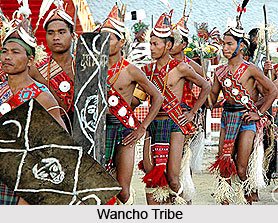 The Morung system that was followed by the Wanchos served as centres for training in the skills of fighting for the youths. They were also used as venue for meetings and discussions of the village and guard houses to protect the village from outrages and accidental damages. Presently the Morung is used by bachelors as centres of recreation and sleeping houses.
The Morung system that was followed by the Wanchos served as centres for training in the skills of fighting for the youths. They were also used as venue for meetings and discussions of the village and guard houses to protect the village from outrages and accidental damages. Presently the Morung is used by bachelors as centres of recreation and sleeping houses.
The Wancho word for Morung is P alpha or Pau. Each village is endowed with several Morungs which vary on the basis of size and divisions of the village. There are two types of Morungs called Panu and Pasa. Community meetings are held at Panu Morung. Apart from these, the Chiefs also have different Morungs called Wanghampa.
The decorations of these Morungs are adorned with wood carvings and skulls of various animals killed in different occasions. The Wanhampa and the Panu Morungs capture more attention because of their beautification that surpasses other Morungs. The Morungs resemble the dwelling houses in their constructions. A big log drum called Kham, is customarily kept in each Morung. Admissions in the Morungs do not have any age bar but very young children are not allowed. The condition to be fulfilled for membership is ability to take part in men`s job which is acquired by a Wancho boy at the age of 12 or 13. On becoming a member of the Morung a boy acquires social rights and privileges and become responsible members of the society.
Morung is constructed and maintained collectively by its members but even the whole village participates in its. Morungs are built on territorial basis and not on social or clan consideration. The inauguration function of the Morung and the establishment of the log-drum are the occasions that are celebrated with much festivity. It is celebrated with community feast. Entry of girls is prohibited inside the boys Morung. They can enter only on the first day when a newly constructed Morung is ceremonially occupied. Girls do not have any separate Morungs. Morung is an important institution in the socio-cultural and political life of the Wanchos.
This article is a stub. You can enrich by adding more information to it. Send your Write Up to content@indianetzone.com
















